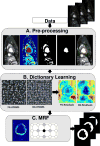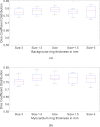Unsupervised Myocardial Segmentation for Cardiac BOLD
- PMID: 28708550
- PMCID: PMC5726889
- DOI: 10.1109/TMI.2017.2726112
Unsupervised Myocardial Segmentation for Cardiac BOLD
Abstract
A fully automated 2-D+time myocardial segmentation framework is proposed for cardiac magnetic resonance (CMR) blood-oxygen-level-dependent (BOLD) data sets. Ischemia detection with CINE BOLD CMR relies on spatio-temporal patterns in myocardial intensity, but these patterns also trouble supervised segmentation methods, the de facto standard for myocardial segmentation in cine MRI. Segmentation errors severely undermine the accurate extraction of these patterns. In this paper, we build a joint motion and appearance method that relies on dictionary learning to find a suitable subspace. Our method is based on variational pre-processing and spatial regularization using Markov random fields, to further improve performance. The superiority of the proposed segmentation technique is demonstrated on a data set containing cardiac phase-resolved BOLD MR and standard CINE MR image sequences acquired in baseline and ischemic condition across ten canine subjects. Our unsupervised approach outperforms even supervised state-of-the-art segmentation techniques by at least 10% when using Dice to measure accuracy on BOLD data and performs at par for standard CINE MR. Furthermore, a novel segmental analysis method attuned for BOLD time series is utilized to demonstrate the effectiveness of the proposed method in preserving key BOLD patterns.
Figures











References
-
- Dharmakumar R, Arumana JM, Tang R, Harris K, Zhang Z, Li D. Assessment of regional myocardial oxygenation changes in the presence of coronary artery stenosis with balanced SSFP imaging at 3.0T: Theory and experimental evaluation in canines. JMRI. 2008;27(5):1037–1045. - PubMed
-
- Oksuz I, Mukhopadhyay A, Bevilacqua M, Dharmakumar R, Tsaftaris SA. Dictionary learning based image descriptor for myocardial registration of CP-BOLD MR. MICCAI. 2015:205–213.
Publication types
MeSH terms
Grants and funding
LinkOut - more resources
Full Text Sources
Other Literature Sources

